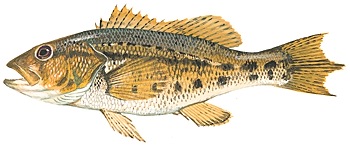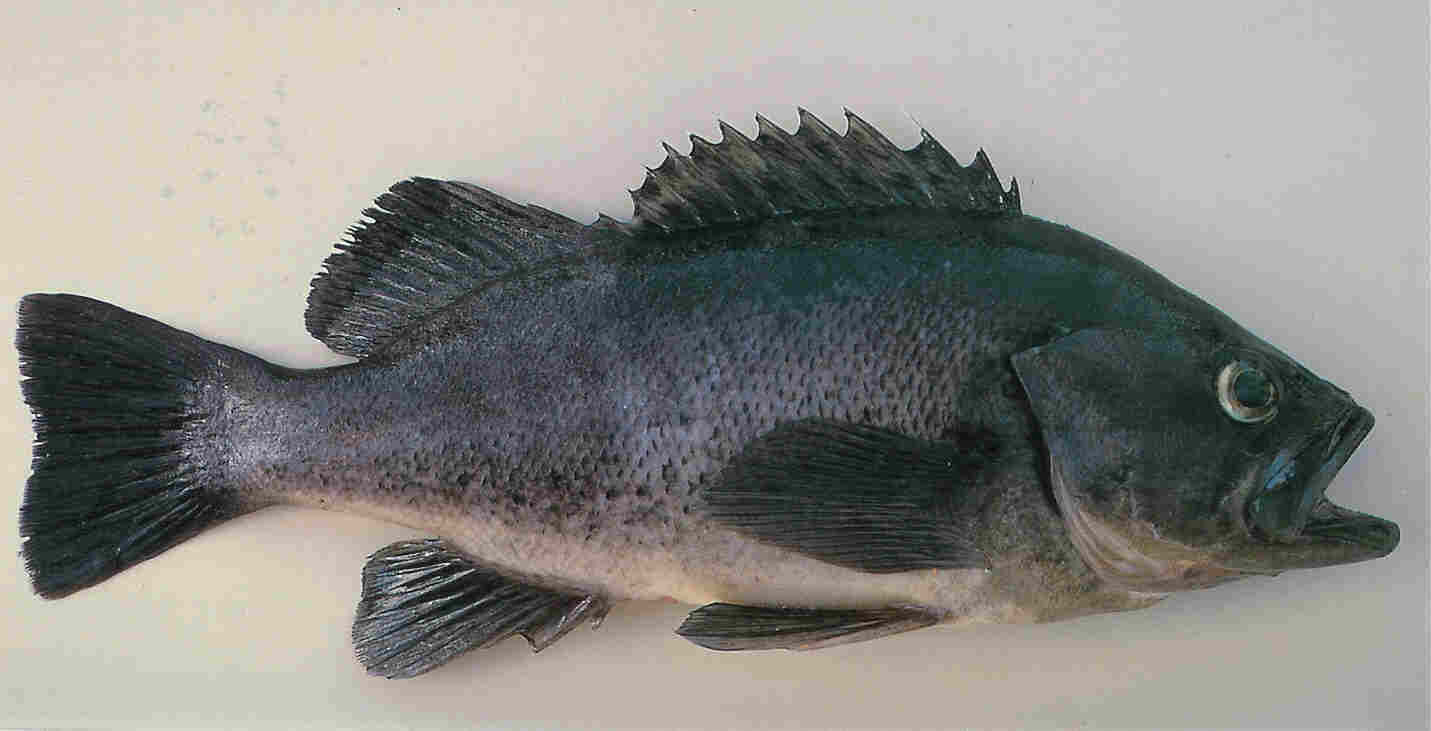Discover Florida Nature
It's time to explore the natural Florida


|
|
|
|
|
 Bank
Sea Bass (Centropristis ocyurus) Bank sea bass are
easily recognized by their large mouths, tapering bodies with tri-lobed
caudal fins, and by their color. Unlike the black sea bass, the bank sea
bass is yellow-brown overall, and is marked with black blotches and
spots. The black markings consist of three longitudinal rows of blotches
on the sides in addition to spots on the dorsal and caudal fins. The
head, fins, and front portion of the body often have blue and yellow
spots and stripes. Found in waters ranging from 50-500 feet, the bank
sea bass is usually associated with hard-bottom habitats and high-relief
areas in deeper waters. They are distributed from Virginia to the
Yucatan Banks, and live up to seven years, reaching lengths of 10.7
inches. Nearly all individuals of this species begin life as females and
change to males as they age and grow. (This hermaphrodism is found in
many fish species.) Collections suggest that fertile females spawn
offshore in the early spring, usually for the first time when they are 2
or 3 years old. A 4-inch fish is capable of spawning over four-thousand
pelagic eggs during one season, and a fish twice the size may lay about
thirty-thousand. The bank sea bass is an opportunistic carnivore that
uses its large mouth to swallow crabs, shrimp, brittle stars, callico
scallops and small fish. Bank
Sea Bass (Centropristis ocyurus) Bank sea bass are
easily recognized by their large mouths, tapering bodies with tri-lobed
caudal fins, and by their color. Unlike the black sea bass, the bank sea
bass is yellow-brown overall, and is marked with black blotches and
spots. The black markings consist of three longitudinal rows of blotches
on the sides in addition to spots on the dorsal and caudal fins. The
head, fins, and front portion of the body often have blue and yellow
spots and stripes. Found in waters ranging from 50-500 feet, the bank
sea bass is usually associated with hard-bottom habitats and high-relief
areas in deeper waters. They are distributed from Virginia to the
Yucatan Banks, and live up to seven years, reaching lengths of 10.7
inches. Nearly all individuals of this species begin life as females and
change to males as they age and grow. (This hermaphrodism is found in
many fish species.) Collections suggest that fertile females spawn
offshore in the early spring, usually for the first time when they are 2
or 3 years old. A 4-inch fish is capable of spawning over four-thousand
pelagic eggs during one season, and a fish twice the size may lay about
thirty-thousand. The bank sea bass is an opportunistic carnivore that
uses its large mouth to swallow crabs, shrimp, brittle stars, callico
scallops and small fish. Rock
Sea Bass
(Centropristis philadelphica.) Rock Sea Bass range North Carolina
to Florida, as well as the eastern Gulf of Mexico to Louisiana. The Rock
Sea Bass live offshore and only reach size of a pound or two. A small
fish, the rock sea bass seldom reaches more than ten inches in length.
The usual size of this bass is .3 pounds, with an average length of
eight inches. Rock Sea Bass can be distinguished by the tri-lobed tail
and the black spot on the Dorsal fin. Rock sea bass are olive-brown or
bronze, with dark blotches forming vertical bars. This grouper has a
dark black blotch on the middle of it's dorsal-fin base. The lips and
tip of the lower jaw of the rock sea bass is purplish, with bright blue
and orange stripes and marking on the head and fins. Rock sea bass have
a fully scaled nape and the tail is distinctly tri-lobed in adults. The
rock sea bass differ from other sea bass in that they prefer sandy or
muddy bottoms. The rock sea bass spawns January through March. Young
adults are predominantly female, transforming into males as they grow
older, like all other grouper fish. Rock sea bass, a member of the
grouper family, feeds on the bottom, taking squid, crustaceans, and
small fish. Rock
Sea Bass
(Centropristis philadelphica.) Rock Sea Bass range North Carolina
to Florida, as well as the eastern Gulf of Mexico to Louisiana. The Rock
Sea Bass live offshore and only reach size of a pound or two. A small
fish, the rock sea bass seldom reaches more than ten inches in length.
The usual size of this bass is .3 pounds, with an average length of
eight inches. Rock Sea Bass can be distinguished by the tri-lobed tail
and the black spot on the Dorsal fin. Rock sea bass are olive-brown or
bronze, with dark blotches forming vertical bars. This grouper has a
dark black blotch on the middle of it's dorsal-fin base. The lips and
tip of the lower jaw of the rock sea bass is purplish, with bright blue
and orange stripes and marking on the head and fins. Rock sea bass have
a fully scaled nape and the tail is distinctly tri-lobed in adults. The
rock sea bass differ from other sea bass in that they prefer sandy or
muddy bottoms. The rock sea bass spawns January through March. Young
adults are predominantly female, transforming into males as they grow
older, like all other grouper fish. Rock sea bass, a member of the
grouper family, feeds on the bottom, taking squid, crustaceans, and
small fish.
 Black
Sea Bass
(Mycteroperca phenax) The black sea bass occurs along
the Atlantic Coast of the United States from Cape Cod to Florida,
reaching greatest abundance between the Capes of New Jersey and North
Carolina. They can be found in inshore bays and sounds and offshore in
waters up to a depth of 130 m (425'). They spend most of their time
close to the sea floor and are often congregated around bottom
formations such as rocks, man-made reefs, wrecks, jetties, piers, and
bridge pilings. Black
Sea Bass
(Mycteroperca phenax) The black sea bass occurs along
the Atlantic Coast of the United States from Cape Cod to Florida,
reaching greatest abundance between the Capes of New Jersey and North
Carolina. They can be found in inshore bays and sounds and offshore in
waters up to a depth of 130 m (425'). They spend most of their time
close to the sea floor and are often congregated around bottom
formations such as rocks, man-made reefs, wrecks, jetties, piers, and
bridge pilings.
Black sea bass are fairly stout-bodied fish, with a long dorsal fin, and large pectoral and pelvic fins. The rounded tail sometimes has a long streamer trailing out from the top edge. Each gill cover has a flat spine near the outer edge. Mature males have a fleshy dorsal hump just anterior to the dorsal fin. The background color of the black sea bass (smokey gray, brown, or bluish black) is mottled with darker patches and light speckles. The belly is only slightly lighter than the sides. The dorsal fin is marked with whitish mottling, while all other fins have dark spots, Young sea bass are green or brown with a dark lateral stripe running from the head to the tail. The Black Sea Bass often rests stationary or cruises slowly around structures. It occasionally rests on the bottom or other structures, staying either head-down or head-up. It enters the smallest corners and caves with a body angle above ground often about 40° down. The dorsal fin is normally folded close to the body, and it is only spread out as an aggressive posture reaction to other sea bass. is stout-bodied, three times taller than long (without caudal fin), and has a high back, flat topped head, moderately pointed snout, large oblique mouth, eye set up high (not as high as in the above image due to its slightly oblique perspective), and one sharp flat spine near the caudal end of the operculum. The general abundance of black sea bass along the East Coast has been declining for over three decades. Further more, the average size fish harvested both commercially and recreationally has been decreasing since about 1950, indication that larger, older fish have become increasingly scarce. |
|
|
Advertise | Privacy Statement | Dog Encyclopedia | Video |Contact | Alaska Nature |
|